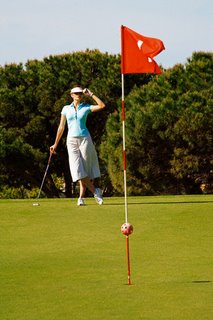Golf Fitness Bangkok
According to Greg Rose, DC, Co-founder of the Titleist Performance Institute, the reverse spine angle is the number one injury-inducing swing fault. I cannot agree more. But let’s examine that assertion: is the swing fault causing the injury, or is there something below the swing fault that is driving the fault and that is the real cause of the injury? I know that Dr Rose agrees with the second part of that statement as well.

Most of the Thailand golf instructors will tell the golfer “do not reverse the spine at the top”, and give drills to that end. They do not seem to clear concept that the physical makeup of the golfer seems to be driving the swing fault most of the time. It’s not that the world’s teacher bad teachers, on the contrary, Thailand golf instructors to me seem to be magicians. They take a person with all of his or her physical imperfections, imbalances and flaws, and somehow manage to help the golfer get the ball airborne and in the general direction of the target. They are really good at helping the golfer “fix” swing faults. Because golf instructors are not trained in human anatomy or biomechanics, the study of human motion, there is no way they could know that the body is responsible for most swing faults and as a result most golf injuries. Give these guys a break…they are doing the best they can with what you give them to work with.
Let’s study this concept of the body and the golf swing more closely. In healthcare we know that the human body is basically flawed. Even the perfect specimens on the tours are flawed in some way. Don’t be insulted ladies and gentlemen on the tour, it is the reality of being human. The Thailand golf tour players, like the rest of us have frame asymmetries, muscle imbalances, flexibility or strength issues, balance challenges, etc. Why would the best in the world still suffer with some of the inconsistencies that we see week to week in their play?
Golfer, you want to play golf, you want to be good at golf, you want to stay healthy so that you can play more at a higher level. You can control this…you can prevent problems…you CAN stay healthy and play good golf. It takes a little bit of work. All you need is a small a team of professionals to help you.
Your golf instructor is your team leader. He or she should be able to screen your body as a part of your lessons. It’s like going to your primary care physician when you are sick. Your primary care physician will evaluate your total situation, and make a diagnosis. If the problem is more involved or more serious your doctor may refer you to a specialist for further evaluation and treatment. We could view the process of being a better golfer in the same way.

Your teaching professional is like your primary care physician. You go to him or her for initial diagnosis of your swing. Sometimes the golf professional will prescribe treatment in the form of drills and practice and whalla you get better and stay healthy sometimes. Your Golf Asia teacher might be trained to fit clubs. If the evaluation proves your clubs are why your golf swing is sick you might be asked to get new clubs. Your teacher might also be trained to understand the body influence on the swing. If that is the case, part of the workup your teacher does might include some basic physical assessment. If your teacher screens your body he or she might find that your body is why your golf swing is ill and why you are injured. In that case he or she may send you to someone trained to deal with the anatomy and biomechanics of the human body.
The idea here is that in addition to your instruction, and club fitting, a quick 5-10 minute body assessment can help identify the risk factors that lead to swing faults and injuries. It is that simple.
There are few key areas that you can look at yourself. You need to look and some simple motions like touching your toes, squatting, trunk stability, range of motion in your hips, spine and shoulders, and how well you coordinated motion between the top and bottom of your torso.
There is the number one injury inducing swing fault Ah, but are the swing faults due to poor concept, poor body or bad habit? Stay tuned.
www.golfthink for golf lessons and golf instruction in Bangkok and thoughout Thailand









0 Comments:
Post a Comment
<< Home